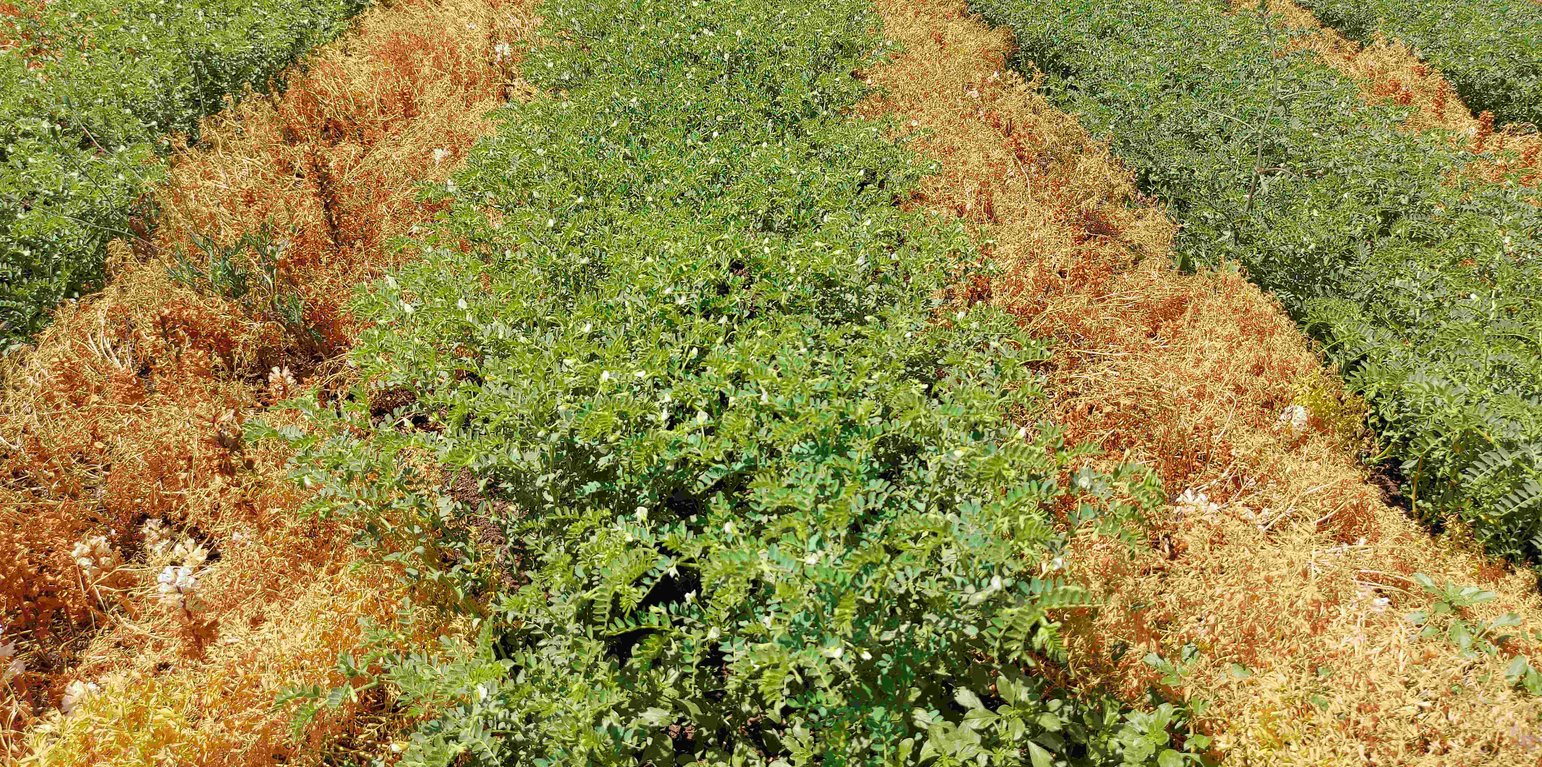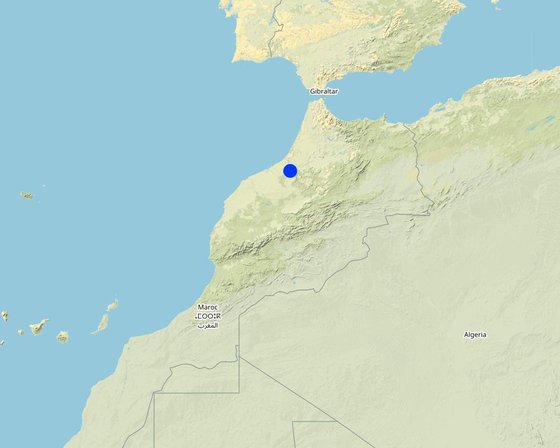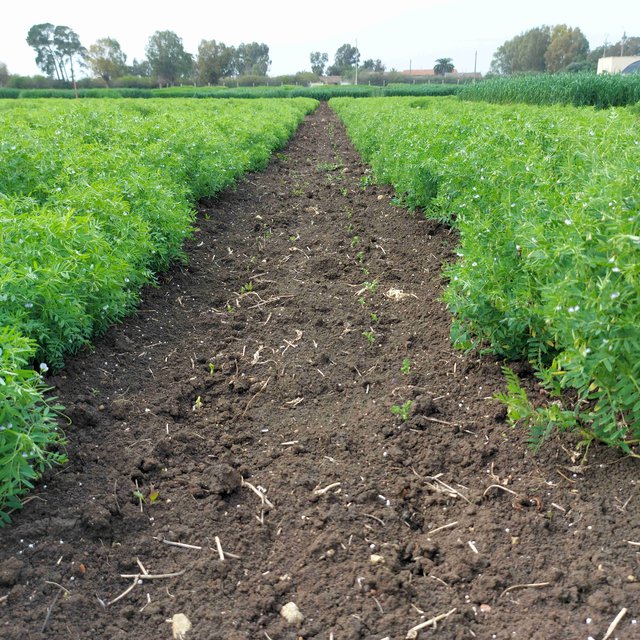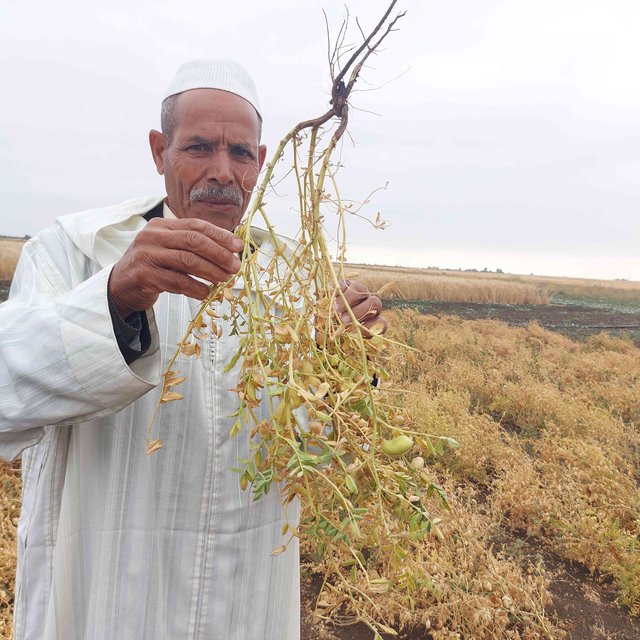



In the semi-arid regions of Morocco, agricultural production varies from year to year, but yields are generally declining because of climate change. Climate change is leading to more irregular rainfall and frequent extreme weather events. Wherever possible, there is a need to intensify agricultural systems to ensure food security while simultaneously increasing resilience.
Cultivating lentils (Lens culinaris) as a sole crop is common practice in rural Morocco. To intensify this cropping system, the International Centre for Agricultural Research Dry Areas (ICARDA) introduced chickpeas (Cicer arietinum) as a relay intercrop into the common lentil production system. Because chickpeas are planted within an already growing crop of lentils, this form of intercropping is termed "relay planting". Importantly, chickpeas do not affect the yields of lentils (0.837 + 0.19 t ha-1 yield in sole vs. 0.808 + 0.159 t ha-1 in intercrop) because they do not significantly compete for water and nutrients. With two crops harvested from the same piece of land, overall farm profits increase. Furthermore, this creates a more resilient production system because the farmer is not dependent on a single crop. Additionally, including chickpeas as a relay-intercrop extends the cropping season and prolongs the period where the soil is covered, consequently protecting it from degradation. An added advantage is that both chickpeas and lentils are leguminous, nitrogen-fixing crops that can improve soil fertility. Also, both crops have high cultural and culinary value locally. However, the technology has potential drawbacks as in years of extreme droughts, chickpeas require supplementary irrigation, especially during establishment. This is often unavailable to local farmers and may result in poor crop establishment and low yields.
In 2020-2022, ICARDA tested this Diversified Cropping System (DCS) on a trial field of half a hectare, in an area with average annual precipitation of 390 mm (based on 40 years of data). The system is implemented as follows. First, the field is prepared by ploughing. In December, lentils are mechanically seeded. Two rows of lentils are planted 15 cm apart. The spacing between each two-row pair is roughly 90 cm. Compound fertilizer is applied during seeding. In January, an herbicide is sprayed to control grassy weeds. The field is mechanically weeded twice, in mid-January and then again in February. Chickpeas are sown at the end of February also in paired lines (two rows 20 cm apart) also with compound fertilizer. Each pair of chickpea lines is planted between pairs of lentils. In March, the plots are manually weeded, and in April, the lentils are manually harvested and mechanically threshed. A single spray of insecticide is applied in April-May. Finally, in June, the chickpeas are mechanically harvested and have an average yield of 1.1 + 0.146 t ha-1.
This documentation illustrates an ICARDA innovation that is accessible since there are no establishment events and costs. This Diversified Cropping System improves a traditional system by introducing an additional crop, resulting in higher farm income and resilience to variable weather.

ສະຖານທີ່: Merchouch, Khémisset Province, ມໍລອກໂກ
ຈໍານວນ ພື້ນທີ່ ທີ່ໃຊ້ ເຕັກໂນໂລຢີ ທີ່ໄດ້ວິເຄາະ: ພື້ນທີ່ດຽວ
ການແຜ່ກະຈາຍຂອງເຕັກໂນໂລຢີ: ນໍາໃຊ້ໃນຈຸດສະເພາະ / ແນໃສ່ນໍາໃຊ້ໃນພື້ນທີ່ຂະໜາດນ້ອຍ
ຢູ່ໃນເຂດປ່າສະຫງວນທີ່ບໍ?: ບໍ່ແມ່ນ
ວັນທີຂອງການປະຕິບັດ: 2021
ປະເພດຂອງການນໍາສະເໜີ







| ລະບຸ ປັດໃຈ ນໍາເຂົ້າ ໃນການຜະລີດ | ຫົວໜ່ວຍ | ປະລິມານ | ຕົ້ນທຶນ ຕໍ່ຫົວໜ່ວຍ (Moroccan Dirham) | ຕົ້ນທຶນທັງໝົດ ຂອງປັດໃຈຂາເຂົ້າ ໃນການຜະລິດ (Moroccan Dirham) | % ຂອງຕົ້ນທຶນທັງໝົດ ທີ່ຜູ້ນໍາໃຊ້ທີ່ດິນ ໃຊ້ຈ່າຍເອງ |
| ແຮງງານ | |||||
| Weeding (Lentil) | Person-Days | 10.0 | 75.0 | 750.0 | 100.0 |
| Weeding (Chickpea) | Person-Days | 10.0 | 75.0 | 750.0 | 100.0 |
| Lentil Harvesting | Person-Days | 10.0 | 75.0 | 750.0 | 100.0 |
| ອຸປະກອນ | |||||
| Plough | Machine-Hours | 3.0 | 150.0 | 450.0 | 100.0 |
| Lentil Seeder | Machine-Hours | 1.0 | 150.0 | 150.0 | 100.0 |
| Chickpea Seeder | Machine-Hours | 1.0 | 200.0 | 200.0 | 100.0 |
| Sprayer | Machine-Hours | 3.0 | 60.0 | 180.0 | 100.0 |
| Weeder | Machine-Hours | 2.0 | 100.0 | 200.0 | 100.0 |
| Lentil Thresher | Machine-Hours | 2.0 | 150.0 | 300.0 | 100.0 |
| Chickpea harvester | Machine-Hours | 2.5 | 300.0 | 750.0 | 100.0 |
| ວັດສະດຸໃນການປູກ | |||||
| Lentil seeds | Kilogram | 45.0 | 8.0 | 360.0 | 100.0 |
| Chickpea seeds | Kilogram | 80.0 | 15.0 | 1200.0 | 100.0 |
| ຝຸ່ນ ແລະ ຢາຊີວະພາບ | |||||
| Herbicide (for Lentil) | Litre | 1.0 | 170.0 | 170.0 | 100.0 |
| Insecticide (for Chickpea) | Litre | 0.25 | 300.0 | 75.0 | 100.0 |
| Fungicide (for Lentil) | Litre | 0.5 | 150.0 | 75.0 | 100.0 |
| NPK 10:20:20 (for Lentil) | Kilogram | 100.0 | 3.0 | 300.0 | 100.0 |
| NPK 10:20:20 (for Chickpea) | Kilogram | 100.0 | 3.0 | 300.0 | 100.0 |
| ຕົ້ນທຶນທັງໝົດ ທີ່ໃຊ້ໃນການບໍາລຸງຮັກສາ ເຕັກໂນໂລຢີ | 6'960.0 | ||||
| ຄ່າໃຊ້ຈ່າຍທັງໝົດ ສຳລັບການບົວລະບັດຮກສາເຕັກໂນໂລຢີ ເປັນສະກຸນເງີນໂດລາ | 654.75 | ||||
Overall crop production increased due to the introduction of an additional crop: chickpeas. No yield reduction was observed in lentils as a sole crop.
Due to the introduction of an additional crop: chickpeas, the risk to complete crop failure was reduced since if one crop fails another exists. This increases resilience.
If rainfall is evenly distributed throughout the growing season, farmers will get good harvests for both crops.
If rainfall occurs in the early season and the late season is dry, farmers will get good lentil harvests but not chickpeas.
Alternatively, if rainfall occurs in the late season with severe drought in the early season, farmers may get complete crop failure of lentils but a good harvest of chickpeas.
Through the introduction of an additional crop: chickpeas, the overall system was diversified.
The introduction of additional crops increased the complexity of the system and its management. For example, planting in the standing lentil needs specialized machinery.
Additional planting material, labor and inputs are required for this cropping system. It may also require supplementary irrigation in the case of late-season drought occurrence.
Two crop harvests (both grains and straw) instead of one increases farm income.
Two harvests of different crops: chickpeas and lentils instead of one diversified farming income streams. This system also allows employment opportunities outside of the main crop growing period.
The introduction of an additional crop complexifies the management and therefore increases the workload.
Having two crops, especially protein-rich legumes promoted food and nutrition security.
Soil coverage for longer times due to the introduction of a second crop later in the season highlights its role in reversing land degradation
There was no significant difference in soil moisture between sole lentils and intercropped lentils (with chickpeas) at the time of lentil harvesting.
Having a second crop later in the season extends the period in which the soil is covered.
Soil coverage mediated by the second crop reduces soil loss due to erosion.
Both crops are leguminous meaning that they contribute to the supply of nitrogen to the soil.